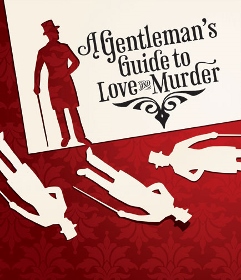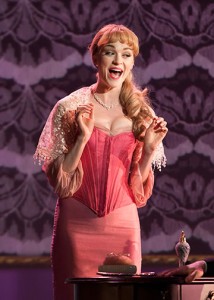CHARM GALORE WITH A SIDE OF CHARM THROWN IN FOR GOOD MEASURE
A Gentleman’s Guide to Love and Murder is a captivatingly charming affair. Set in Edwardian England, the west coast premiere is loosely based on Roy Horniman’s Israel Rank: The Autobiography of a Criminal, which was adapted for the screen as 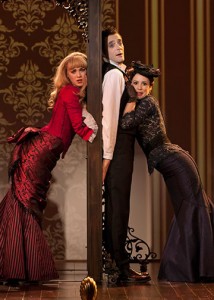 the 1949 black comedy Kind Hearts and Coronets starring Alec Guinness. This Broadway bound incarnation began in 2006 at the Sundance Institute Theater Lab and moved to The Hartford Stage before settling at The Old Globe.
the 1949 black comedy Kind Hearts and Coronets starring Alec Guinness. This Broadway bound incarnation began in 2006 at the Sundance Institute Theater Lab and moved to The Hartford Stage before settling at The Old Globe.
At the funeral of his beloved mother, Monty Navarro (Ken Barnett) is let in on a dirty little secret. It seems dear ole Mum, once a society darling, was disinherited by her well-to-do family when she married a foreigner. What’s more, Monty learns he is in fact ninth in line to inherit a dukedom. Just one problem: eight members of the D’Ysquith clan (all played by Tony-winner Jefferson Mays) stand in his way. He decides to avenge his mother’s banishment and better his station in life at the same time. One by one he helps the D’Ysquiths shuffle off their mortal coils and meet their rather untimely demise.
The tale unfolds as a story within a story, or more accurately, a stage within a stage presentation. There is a passerelle, or semi-circular walkway, around the orchestra pit and a large replica of an English music hall proscenium complete with red 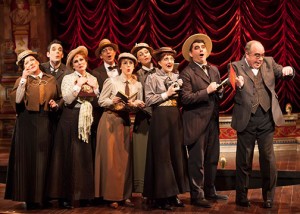 curtains. When opened, different settings are revealed utilizing more traditional theatrical set pieces and Aaron Rhyne’s video projections. Alexander Dodge’s astounding set is like viewing a picture of a picture within a picture.
curtains. When opened, different settings are revealed utilizing more traditional theatrical set pieces and Aaron Rhyne’s video projections. Alexander Dodge’s astounding set is like viewing a picture of a picture within a picture.
The English music halls of that era catered to the drunken masses and featured a wide array of variety acts from Houdini to dancers to Chaplin-esque comedians. Singers were infamous for performing songs filled with innuendo and bawdy, ribald lyrics. The audience never knew what to expect when the curtain would open and the effect is much the same here.
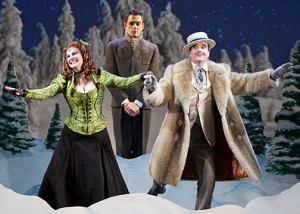 However, in lieu of wild and wicked, what we get is much more restrained and reserved: a refined comedy of manners more suited to a parlor than a music hall. Despite the unsavory plot points, it all seems so perfectly polite and proper. The end result is a grin rather than a guffaw, but it’s a grin that will be on your face from start to finish. Not that there aren’t some hearty laughs to be had because there are – several sight gags like an ice skating adventure and the clownishly buxom bosom and rotund bottom of Lady Hyacinth are particularly funny. Overall, it is the absurd and quite contagious pleasantness that ultimately sells the show.
However, in lieu of wild and wicked, what we get is much more restrained and reserved: a refined comedy of manners more suited to a parlor than a music hall. Despite the unsavory plot points, it all seems so perfectly polite and proper. The end result is a grin rather than a guffaw, but it’s a grin that will be on your face from start to finish. Not that there aren’t some hearty laughs to be had because there are – several sight gags like an ice skating adventure and the clownishly buxom bosom and rotund bottom of Lady Hyacinth are particularly funny. Overall, it is the absurd and quite contagious pleasantness that ultimately sells the show.
While much of the credit for the tone can go to director Darko Tresnjak, it’s Robert L. Freedman’s book and lyrics and Steven Lutvak’s music, lyrics and vocal arrangements that elevate the show to another level completely. Although none of 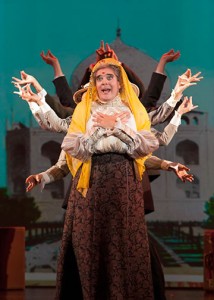 the melodies stick with you for long, they are delightful to listen to with an overall effect as soothing as a minuet or a harpsichord concerto on a sundrenched afternoon. Mr. Freedman’s lyrics are clever and complex, his rhymes remarkable and unexpected. You find yourself hanging on his every turn of phrase. He writes as if he were the secret love child of Stephen Sondheim and Gilbert and Sullivan. All of the songs serve a higher purpose, define the characters, advance the plot and succeed stupendously. At one point I even think my ears were tingling from being so deliciously titillated.
the melodies stick with you for long, they are delightful to listen to with an overall effect as soothing as a minuet or a harpsichord concerto on a sundrenched afternoon. Mr. Freedman’s lyrics are clever and complex, his rhymes remarkable and unexpected. You find yourself hanging on his every turn of phrase. He writes as if he were the secret love child of Stephen Sondheim and Gilbert and Sullivan. All of the songs serve a higher purpose, define the characters, advance the plot and succeed stupendously. At one point I even think my ears were tingling from being so deliciously titillated.
The choreography by Peggy Hickey is pretty much creative walking but perfectly suited for the show. All the other technical aspects – Philip S. Rosenberg’s lights, Linda Cho’s costumes, Dan Moses Schreier’s sound and Charles Lapointe’s wig design – are top-drawer.
From the ensemble all the way up to the leads, the entire cast turns in stellar performances. Lisa O’Hare exudes a wistful and naïve innocence as Sibella, who wins Monty’s heart even though she is really a conniving and calculating gold digger; the quality of O’Hare’s onstage persona is reminiscent of Glynnis Johns as Desiree in A Little Night Music. Chilina Kennedy plays the soon-to-be widowed Phoebe, who seizes the 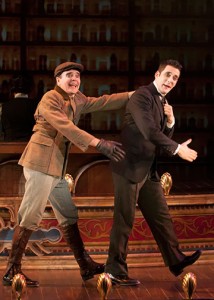 moment and pounces on Monty like a cat on a mouse. Both women have beautiful and expressive legit voices. I was a bit disappointed in Jefferson Mays as the eight D’Ysquiths, although it’s probably his own fault: He simply set the bar too high after playing 37 roles and winning every award under the sun for his bravura solo performance in I Am My Own Wife. He created a tough act to follow for himself. He does create believable portrayals, but I would have liked to have seen more variance from character to character. The director may have wanted to keep the acting on the DL, but I think he could have given Mr. Mays a bit more leeway to broaden his interpretations, especially when it came to Lady Hyacinth, the society matron on a mission to find a cause célèbre. It was all a bit too tame and similar. The true star of the show is Ken Barnett. As Monty, he commands the stage from the moment the show starts and does not relinquish the reigns throughout. His disarming demeanor wins you over completely; you root for him despite the slight detail that he’s a serial killer.
moment and pounces on Monty like a cat on a mouse. Both women have beautiful and expressive legit voices. I was a bit disappointed in Jefferson Mays as the eight D’Ysquiths, although it’s probably his own fault: He simply set the bar too high after playing 37 roles and winning every award under the sun for his bravura solo performance in I Am My Own Wife. He created a tough act to follow for himself. He does create believable portrayals, but I would have liked to have seen more variance from character to character. The director may have wanted to keep the acting on the DL, but I think he could have given Mr. Mays a bit more leeway to broaden his interpretations, especially when it came to Lady Hyacinth, the society matron on a mission to find a cause célèbre. It was all a bit too tame and similar. The true star of the show is Ken Barnett. As Monty, he commands the stage from the moment the show starts and does not relinquish the reigns throughout. His disarming demeanor wins you over completely; you root for him despite the slight detail that he’s a serial killer.
If you are a fan of the droll delirium of Downton Abbey this show is for you. Sit back, smile and be prepared to have the pants charmed right off of you.
photos by Henry DiRocco
A Gentleman’s Guide to Love and Murder
The Old Globe Theatre in San Diego
scheduled to end on April 14, 2013
for tickets, call (619) 23-GLOBE
or visit http://www.TheOldGlobe.org
